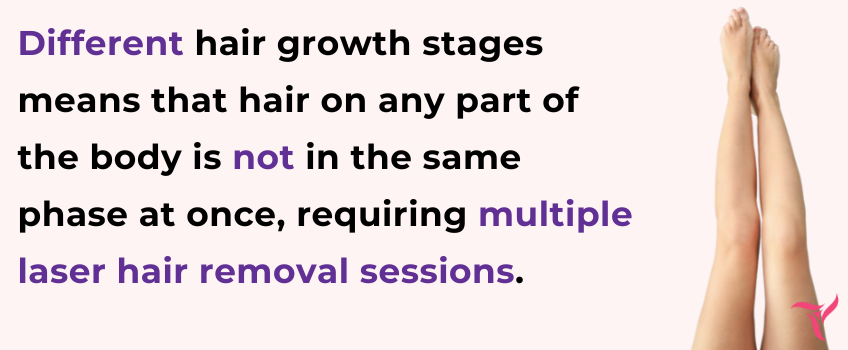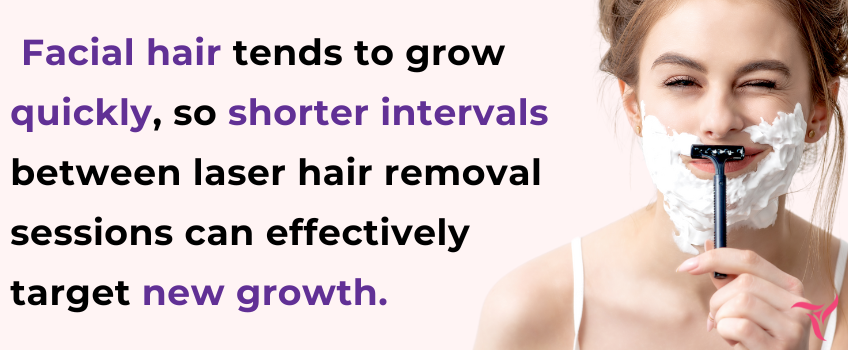How long to wait between laser hair removal treatments is a key question for anyone seeking optimal results. Achieving smooth, hair-free skin through laser hair removal is a popular goal, and understanding the optimal interval between sessions is crucial. This guide explores the ideal timing for laser hair removal, especially when using advanced technology like the Candela GentleMax Pro Plus, and why spacing your treatments correctly is essential.
If you’re considering laser hair removal in Toronto, knowing these details will help you maximize your results and ensure a comfortable, effective experience.
Perfecting the Pause: Optimal Interval Between Your Laser Hair Removal Sessions
Laser hair removal, particularly with the highly effective GentleMax Pro Plus, promises long-lasting smoothness. However, many patients wonder about the ideal gap between sessions. This post delves into the optimal timing, the science behind it, and key factors to consider for a successful laser hair removal journey, ensuring you understand how to best leverage this advanced technology for your needs.
Why is There a Wait Between Laser Hair Removal Sessions?
The time between laser hair removal sessions is vital for several reasons, each playing a crucial role in the overall efficacy and safety of the procedure. Understanding these reasons will empower you to make informed decisions about your treatment plan.
1. Hair Growth Cycles: Targeting the Anagen Phase for Maximum Impact
Understanding hair growth cycles—anagen (growth), catagen (transitional), and telogen (resting)—is essential for effective laser hair removal. The laser targets melanin in the hair follicle, making the anagen phase the most effective for treatment. Here’s a detailed breakdown:
Anagen (Growth Phase): The active growth phase, lasting several years, is when laser treatments are most effective. The hair is directly connected to the follicle, rich in melanin, which the laser targets. During this phase, the hair follicle is robust and fully receptive to the laser’s energy, allowing for optimal absorption and destruction. This is why targeting hair in the anagen phase is crucial for achieving long-lasting results.
Catagen (Transitional Phase): This 2-3 week phase sees the follicle shrink and detach, reducing treatment effectiveness. As the follicle begins to separate from the blood supply, the amount of melanin decreases, making it harder for the laser to effectively target and destroy the hair root. Treating hair in this phase may lead to temporary reduction, but it’s less likely to result in permanent hair loss.
Telogen (Resting Phase): Lasting several months, this phase is when the follicle is inactive, making laser treatments least effective. During the telogen phase, the hair is dormant and not connected to the blood supply. The follicle is essentially resting, and the old hair shaft is shed as a new hair begins to form. Since there’s minimal melanin present, the laser has difficulty targeting the follicle, rendering treatments during this phase ineffective.
Because hair follicles are in different phases at any time, multiple sessions are required. Spacing treatments allows follicles in catagen and telogen to enter anagen, maximizing laser effectiveness and ensuring lasting results. By adhering to the recommended intervals, you ensure that a higher percentage of hair follicles are in the anagen phase during each session, leading to more efficient and effective hair reduction.
2. Importance of Skin Recovery: Minimizing Side Effects and Promoting Healing
Laser hair removal uses intense light to target melanin, and proper spacing is crucial for skin recovery. Here’s why:
Mitigation of Side Effects: Redness, swelling, and sunburn-like sensations are common but temporary side effects. Proper spacing minimizes these. Allowing sufficient time between sessions gives the skin ample opportunity to recover from the thermal energy delivered by the laser. This reduces the risk of prolonged redness, swelling, or irritation, ensuring a more comfortable experience.
Prevention of Pigmentation Changes: Hyperpigmentation or hypopigmentation, especially in darker skin tones, can be avoided with adequate healing time. Pigmentation changes occur when the laser disrupts the normal melanin production in the skin. By allowing the skin to fully recover between sessions, you minimize the risk of these changes, ensuring a more even and natural skin tone.
Letting your skin heal is super important after laser hair removal. It cuts down on irritation and helps your skin naturally repair itself. This is especially important when considering how long to wait between laser hair removal sessions.
Between treatments, your skin is busy regenerating new cells and healing any tiny damage. This keeps your skin healthy and looking good. Understanding how long to wait between laser hair removal will allow for this natural healing process to occur.
Also, enough healing time stops heat from building up in your skin. That buildup can cause irritation or even damage down the road. So, giving your skin a break is key, and knowing how long to wait between laser hair removal will protect your skin.
Post-Treatment Care: Follow post-treatment instructions, including gentle skincare and sun protection, to support skin recovery. This includes avoiding harsh chemicals, exfoliants, and direct sun exposure. Using gentle cleansers, moisturizers, and sunscreen with high SPF can help soothe the skin and protect it from further irritation, promoting faster and more effective healing.
3. Maximizing Effectiveness: Targeting New Growth and Enhancing Results
Timing is everything when it comes to laser hair removal. Spacing treatments correctly lets us target new hair follicles in their active growth phase, which means better results from each session.
Hair grows in cycles, and the laser works best on follicles in the anagen phase. That’s why knowing how long to wait between laser hair removal sessions is so important.
If you come in too soon, we’ll miss follicles that are still dormant. Wait too long, and new growth might slip through. Generally, facial hair needs treatments every 4-6 weeks, and body hair every 6-8 weeks.
But everyone’s different! Your personal growth pattern and the areas being treated will affect the best schedule for you.
This tailored approach ensures you get the most out of your sessions, leading to noticeable and lasting hair reduction. It’s not a one-size-fits-all thing, and a personalized plan is key. Plus, the type of laser being used will also play a role in determining the ideal spacing.
So, How Long to Wait Between Laser Hair Removal Sessions?
Recommended intervals vary based on the treated area and individual factors:
Facial Hair: 4-6 weeks. Facial hair tends to grow more rapidly due to hormonal influences and a higher concentration of active follicles. Shorter intervals ensure that new growth is targeted efficiently, leading to faster and more noticeable results.
Body Hair: 6-8 weeks. Hair growth on the body, such as the underarms, bikini area, and torso, is generally slower than facial hair. A slightly longer interval allows for more follicles to enter the anagen phase, maximizing the impact of each session.
Legs and Arms: 8-10 weeks. These areas typically have the slowest hair growth rate. Longer intervals are suitable for allowing a significant portion of follicles to reach the anagen phase, ensuring effective treatment and minimizing unnecessary sessions.
Consult your laser technician for personalized advice based on your hair growth and skin response. Professional technicians can assess your individual needs and tailor a treatment plan that optimizes results while minimizing discomfort and potential side effects. They can also provide guidance on post-treatment care and address any concerns you may have.
What is the GentleMax Pro Plus? Advanced Technology for Superior Results
The Candela GentleMax Pro Plus is an advanced laser hair removal system using dual-wavelength technology (Alexandrite and Nd:YAG) to treat various skin types and hair colors effectively. This dual-wavelength approach allows for greater versatility and precision, ensuring optimal results for a wider range of patients. It offers upgrades like enhanced efficiency, improved cooling, and broader skin type accommodation, making it a leading choice for laser hair removal.
Dual-Wavelength Technology: The GentleMax Pro Plus combines the Alexandrite laser (755 nm) and the Nd:YAG laser (1064 nm). The Alexandrite laser is highly effective for lighter skin tones and finer hair, while the Nd:YAG laser is ideal for darker skin tones and coarse hair. This combination allows for customized treatments that cater to individual needs, ensuring safety and efficacy.
Enhanced Efficiency: The GentleMax Pro Plus delivers faster and more powerful pulses, reducing treatment time and increasing efficiency. This means shorter sessions and potentially fewer overall treatments required to achieve desired results. The advanced technology ensures consistent energy delivery, leading to more uniform and effective hair reduction.
Improved Cooling System: Comfort is a priority during laser hair removal. The GentleMax Pro Plus features an advanced Dynamic Cooling Device (DCD) that sprays cryogen onto the skin before each laser pulse, minimizing discomfort and protecting the skin from thermal damage. This enhanced cooling system ensures a more comfortable experience, even during longer sessions.
Broader Skin Type Accommodation: The GentleMax Pro Plus is designed to safely and effectively treat a wider range of skin tones, including very light and very dark skin. This versatility makes it a suitable option for diverse patient populations, ensuring that more individuals can benefit from laser hair removal. The advanced technology minimizes the risk of pigmentation changes, making it a safe choice for all skin types.
Understanding Individual Variations and Factors Affecting Treatment Intervals
While general guidelines exist for treatment intervals, individual variations play a significant role in determining how long to wait between laser hair removal sessions. Factors such as hair thickness, density, color, and growth rate, as well as skin type and hormonal influences, can affect the optimal timing between sessions.
A thorough consultation with a qualified technician at a reputable clinic, like when considering laser hair removal in Toronto, is crucial to assess these factors and develop a personalized treatment plan. This personalized approach ensures you’re not waiting too long, allowing hairs to enter resting phases, or too short, potentially causing unnecessary skin irritation. Understanding your unique characteristics is vital for maximizing treatment effectiveness and achieving long-term hair reduction.
Hair Characteristics: Thicker, darker hair typically responds more effectively to laser treatments, requiring fewer sessions and potentially longer intervals. Finer, lighter hair may require more frequent sessions and shorter intervals to achieve optimal results. Understanding *how long to wait between laser hair removal* appointments, specifically for your hair type, is key. The anagen (growth) phase is when the laser is most effective, and this varies depending on hair characteristics.
Skin Type: Individuals with lighter skin tones and darker hair generally experience faster and more noticeable results with laser hair removal. Those with darker skin tones or lighter hair may require more sessions and careful adjustments to laser settings, potentially utilizing specialized technology like the Candela GentleMax Pro Plus, to minimize the risk of side effects and ensure effective treatment. Determining the correct laser hair removal spacing is paramount for safety and efficacy, regardless of skin type.
Hormonal Influences: Hormonal fluctuations can significantly affect hair growth, particularly in areas such as the face and bikini line. Individuals with hormonal imbalances, such as PCOS, may require more frequent maintenance sessions, or adjusted intervals between their initial laser hair removal treatments, to manage new hair growth. This makes personalized planning even more important when deciding how long to wait between laser hair removal.
Treatment Area: Different body areas have varying hair growth rates and densities. For example, facial hair tends to grow faster than leg hair, requiring shorter intervals between sessions.
Conclusion: Patience and Precision for Lasting Laser Hair Removal Results
In conclusion, understanding how long to wait between laser hair removal sessions is paramount to achieving the best possible results. By adhering to a treatment schedule tailored to your individual needs and hair growth cycle, particularly when using advanced technology like the GentleMax Pro Plus, you significantly increase your chances of long-term hair reduction. Remember that patience and consistency are key. Don’t hesitate to discuss any concerns or questions about laser hair removal spacing with your provider during your laser hair removal in Toronto. Ultimately, the proper waiting period ensures a safer, more effective, and ultimately more satisfying laser hair removal journey, leading to the smooth, hair-free skin you’ve been seeking.
Ready to begin your journey to smooth skin? Contact LMC – Laser Medical Clinic today!
Text or Call: 647-560-8333
To book your complimentary consultation appointment, call us at 416-548-6548
Book a Consultation


